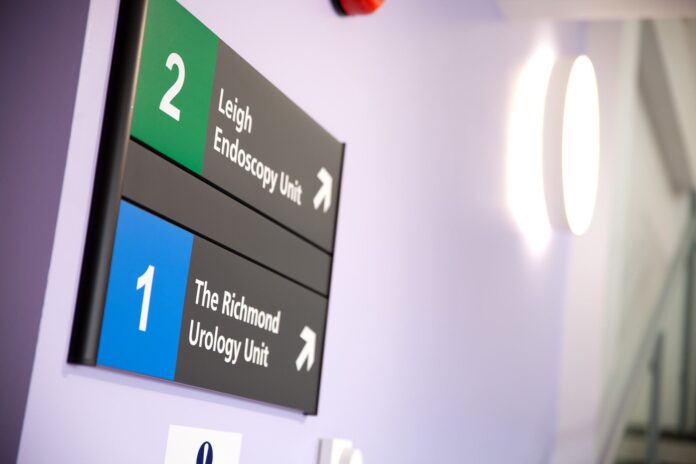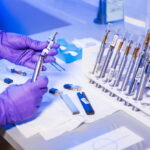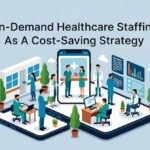Healthcare settings are full of different types of signage, from directional signs to health and safety recommendations. The various messages must be clear and simple yet informative to keep the patients informed and positive about their experiences.
Printed VS Digital Signage
Within most healthcare settings, printed signage is the most popular form of signage as it is cheap, easy to install and easy to maintain. However, as providers embrace the digital age there has been a rise in digital signage. Digital signage is becoming more affordable and effective therefore is an increasingly popular upgrade for hospitals.
Printed signage is traditionally for simple, static messages such as directions, healthcare posters and health and safety protocols. In places such as clinics or busy departments, digital signage can be employed to display evolving messages such as department wait times, health news updates, reminder messages or even entertainment.
In what ways is signage used in hospital settings?
If you consider the user experience, their journey generally starts in the car park as they enter. Many hospitals have certain parking areas for different departments so having a clear direction board as close to the entrance but at a safe distance from the road is key. Equally, if there are designated staff-only parking spaces then these need to be signposted as clearly as possible to avoid confusion and spaces being taken up incorrectly.
If there is a national or regional health drive, the type of signage used will be different. For example, as flu season approaches you may want to commission some roller banners to stand in key locations and departments and remind people that you can get free boosters if you are eligible. This is an effective way of making sure people remember to get their flu vaccines.
Hospitals can be huge spaces, so directional signage either overhead or on a large board inside is paramount. By clearly marking the entrances, exits, key departments and any amenities such as a café or lift, the stress level of the patient will be reduced and help to keep departments running on time rather than chasing after lost people.
In certain departments, having a digital screen displaying waiting times would be very helpful. If a patient is sat in a blood test clinic, having a rough waiting time will prevent them from getting agitated about how long they have been waiting. As much as these screens can be informative, you may wish to have entertainment on them as well, such as the news headlines or the weather.
Safety protocols need to be displayed clearly so that everyone visiting knows what is expected of them. If a one-way system is in place it may be worth doubling the signage to include stickers on the floor as well as the walls or hanging overhead. Having bright signage above hand washing stations is helpful as the bright colours draw the eye in and remind people to follow the hygiene rules.
Read Also
- Creative Approaches to Alleviating Healthcare Staff ShortagesHospitals and clinics are facing staff shortages, which makes it harder to take care of patients well. Finding simple and useful solutions is very important. Easy changes like flexible work hours, good training, and chances to grow can help staff stay happy. Technology, like online doctor visits and helpful tools, can make work easier. Smart… Read more: Creative Approaches to Alleviating Healthcare Staff Shortages
- Understanding the Role of Sterilizers in Healthcare FacilitiesHave you ever wondered how hospitals keep their equipment safe enough to use on dozens of patients every day? Most people never think about what happens behind the scenes, yet these hidden steps play a huge role in patient safety. Sterilizers are part of that system, working quietly to remove harmful germs before any instrument… Read more: Understanding the Role of Sterilizers in Healthcare Facilities
- Building Healthcare Access Where It’s Needed Most: A Local First ApproachHealthcare shouldn’t depend on where you live. But in the U.S., it often does. If you’re in a big city, you likely have options. If you’re in a small town or an underserved neighbourhood, it’s a different story. To fix this, more healthcare leaders are turning to a local-first approach. That means putting clinics and… Read more: Building Healthcare Access Where It’s Needed Most: A Local First Approach
- Revolutionizing Patient Engagement: Innovative Solutions for Improved Care and Treatment SuccessNavigating healthcare system can often feel overwhelming for patients. Between appointments, prescriptions, and treatment regimens, it’s easy for crucial details to get lost in the shuffle. That’s why effective patient engagement and support solutions are more important than ever. Companies like Serva Health, with their pharma hub services, are stepping up to ensure that patients… Read more: Revolutionizing Patient Engagement: Innovative Solutions for Improved Care and Treatment Success
- On-Demand Healthcare Staffing As A Cost-Saving StrategyThis is an exciting and challenging time for the healthcare industry. Technology is advancing almost faster than humans can keep pace. New legislation is creating fresh challenges for the future of healthcare, and the shifting population demographic continues to place more pressure on healthcare facilities. Amidst these changes, healthcare facilities are facing a critical staffing… Read more: On-Demand Healthcare Staffing As A Cost-Saving Strategy
- The Benefits of Contract Labor Staffing in HealthcareThe most successful healthcare facilities today aren’t just reacting to crises—they are building workforce resilience to withstand them. Unpredictable patient demand, coupled with persistent nursing shortages, has made the traditional staffing model obsolete. Relying on mandatory overtime to cover a sudden surge in capacity is a recipe for high turnover and rising employee burnout relief… Read more: The Benefits of Contract Labor Staffing in Healthcare







